Customer experience is the new battleground in the world of brand building. Not price. Not product. Brands aiming to win and keep customers must conquer customer experience (CX).
Forrester defines CX as, “every interaction, or touch point, your customer has with your brand. It not only includes the what (the interaction), but also the how (perceptions, feelings) of the customer experience.”
Whose job is it to improve customer experience?
Tough question.
Managing CX, according to Gartner, is the practice of designing and reacting to customer interactions to meet or exceed expectations to increase customer satisfaction, loyalty and advocacy.
Looking back, companies tended to look to customer support, product, and various other departments to tackle CX responsibilities. Today, it’s widely understood “other departments” includes marketing—and in a big way.
Though customer experience spans the organization—serving customers both before and during the relationship—marketers must understand their immense role in the overall customer experience and take ownership of it.
“There are two keys to CX: empathy and curiosity,” writes Sue Duris on the Openview blog. “You have to care enough about the customer—in fact, your customers should be the single most important thing you care about—and be interested enough to understand their pains, motivators, needs and wants, to help them meet those expectations to achieve success.”
This is where agencies come in—there’s an opportunity to help marketers command this immense role in CX with personalization efforts.
Enter a game-changer: what is personalization?
Buyers no longer tolerate anything less than stellar experiences. Maybe Amazon’s to blame—or thank. And, to follow their lead, brands across the spectrum of product and service categories seek to seize a lead by stepping-up their ability to personalize their communications throughout the customer lifecycle.
“Customers expect brands to know what they’re interested in, what they need now, and even what they might need in the future.” ~ Wilson Raj, SAS
Personalization has truly become central to a systemic shift in marketing. The benefits can be immense:
- Personalization can improve average order values by upwards of 40% and conversion rates improve by an upwards of 600%. (Source)
- 68% of firms state that delivering personalized experiences is a priority. (Source)
- 74% of consumers get frustrated when website content appears that has nothing to do with their interests. (Source)
- 78% of U.S. Internet users said personally relevant content from brands increases their purchase intent. (Source)
- 75% of consumers are more likely to buy from a retailer that recognizes them by name, recommends options based on past purchases, OR knows their purchase history. (Source)
Accenture developed a “4R Personalization Framework,” which introduces the keys to personalization in a tidy and memorable way:
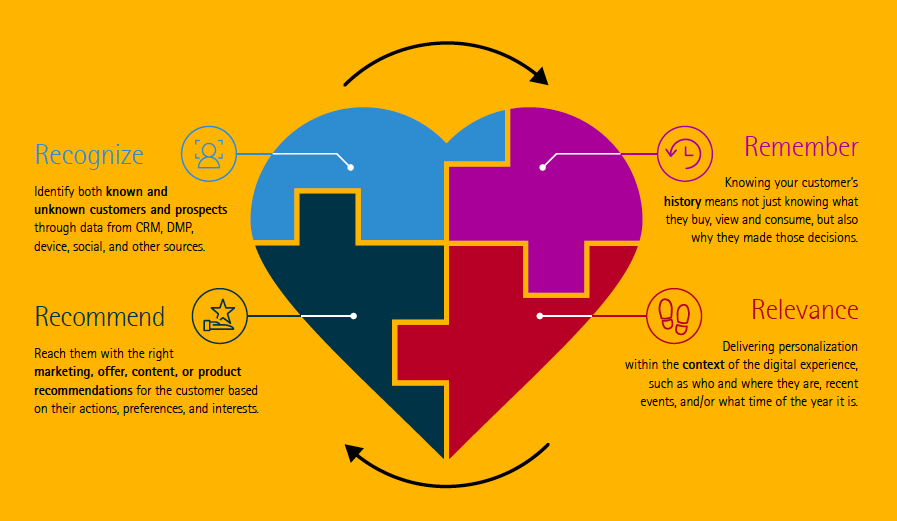
91% of consumers are more likely to shop with brands who recognize, remember and provide relevant offers and recommendations. (Accenture Interactive, Making It Personal)
Why doesn’t every brand already nail personalization?
Though marketers have been buzzing about the idea of one-to-one marketing since Peppers & Rogers gave birth to the expression decades ago, few companies have done much more than talk about it.
It’s hard.
Witness this data from Dynamic Yield’s 2019 Personalization Maturity Assessment:
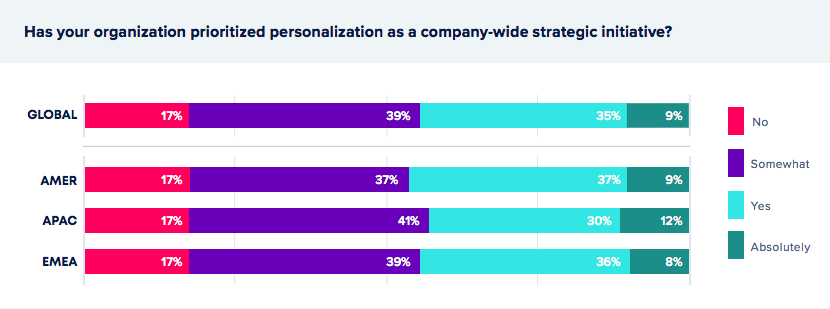
Although 97% of American and APAC marketers believe personalization is valuable, the majority of companies still can’t say they’re prioritizing it as a strategic initiative.
Nor can they say they’re nailing it.
Accenture wanted to determine if businesses are swiftly improving customer experiences and meeting consumer expectations for personalization. Gong!
They surveyed 8,000 consumers across the globe and the data showed consumers are leaving brand websites and making purchases elsewhere at a higher rate than a year ago.
Expectations are growing faster than the experiences are evolving.
Brands are struggling with technology, strategy, budgets, organizations, staff skills, and other obstacles to success. Technical challenges appear to loom largest.
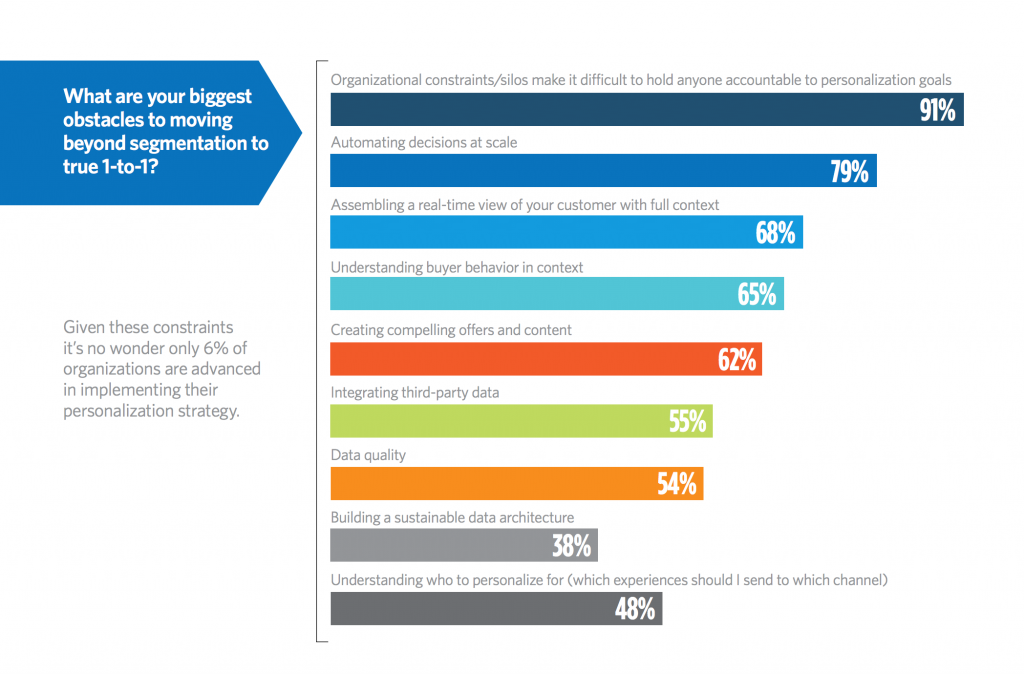
Data from a 2017 Personalization Development Study by Monetate
How agencies can help brands master personalized marketing
For most, the on-ramp to personalization at scale will be bumpy.
Just as brands task agencies to provide the guidance and execution needed to take advantage of marketing automation, most are bound to seek assistance yet again in the personalization arena. Digital agencies that have earned their stripes in performance marketing and have a strong command of martech can step-up and lead.
Smoothing the ride requires a carefully planned strategy and the right technology. In broad terms, success will depend on:
- Recognizing and reaching the right consumers across devices and channels
- Building individualized profiles that are enriched with each interaction
- Making data-informed decisions about the best message to deliver
- Measuring the impact of those efforts across all channels
Clearly, with each of the important challenges above, it’s imperative to flick the technology switch. As a trusted advisor to clients that want to get serious about personalization, you’ll be venturing into an important new software space: the customer data platform (CDP).
A new breed of SaaS, CDP delivers the data-driven performance marketer’s holy grail in the form of a unified view of the customer. According to Gartner, CDPs are gaining widespread attention from marketers because they provide “a holistic view of the customer to help execute and optimize personalized journeys.”
A CDP is not a CRM or a marketing automation platform (MAP). CDPs fuel the personalization machine by providing marketers a central location for customer data—all customer data—to create the all-important single customer view.
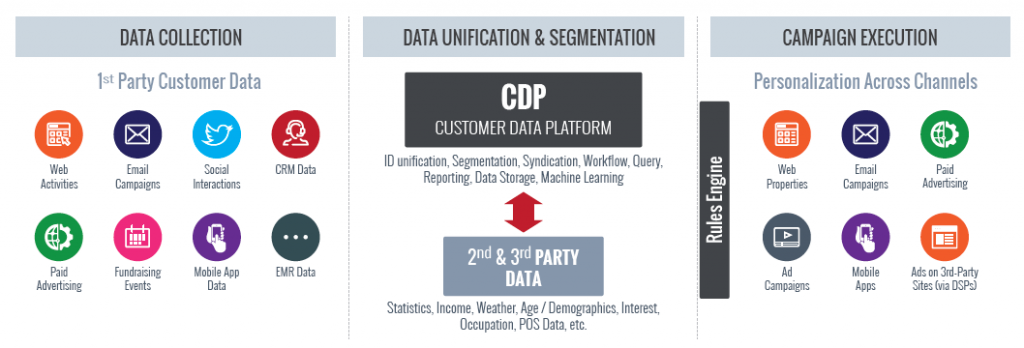
This handy graphic from Element Solutions sheds light on the jobs performed by the customer data platform.
Where will you put personalization to work?
With the proper technology in place, brands are able to deliver personalization across the customer journey, across devices, and offline, with executions including personalized:
- Site search
- Merchandising
- Email marketing
- Content recommendations
Where? In creating the 2017 State of Personalization Report, Segment (a customer data infrastructure company) asked consumers in which of those channels it was most important to have a personalized experience, where brands are succeeding, and where they need improvement. The results:
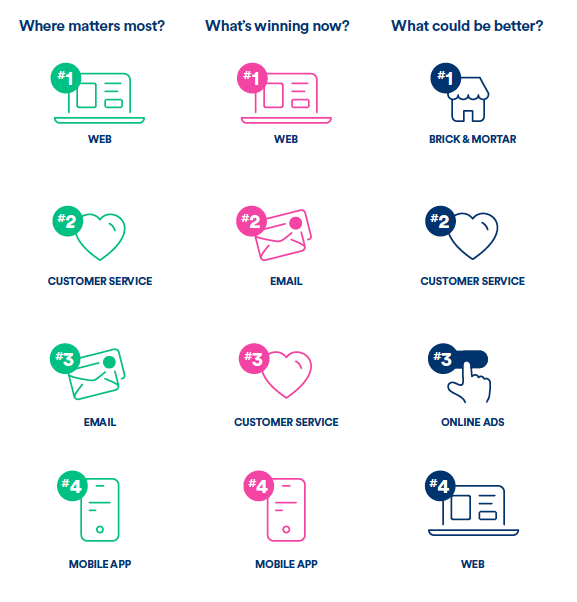
Some other findings of interest from the study include:
- 54% of consumers expect to receive a personalized discount within 24 hours of identifying themselves to a brand (such as by submitting their email or signing up for an account).
- 49% of shoppers have purchased a product that they did not initially intend to buy after receiving a personalized recommendation from a brand.
- Brick and mortar stores are the channel most likely to drive last minute purchases worth more than $50; however nearly 25% of consumers said that the channel needs the most improvement with respect to personalization efforts.
What about advertising?
Yes, count advertising in.
- 71% say they prefer ads that are tailored to their personalized interests and shopping habits. (Source)
- 75% prefer fewer ads that are aligned to their needs and interests. (Same source)
Consumers say they prefer personalized advertising because it reduces irrelevant advertising, helps them discover products they like and makes online searching and shopping faster and easier. Advertisers like it because it boosts engagement and sales.
So, what do consumers think personalized advertising means? According to the Adlucent study I just cited, 87% believe personalized advertising means unique content, based on their previous purchases or shopping behavior and delivered at a time when they are looking to buy.
Instapage claims there are six levels of advertising personalization with the highest level including:
- Targeting based on the combination of need or want
- Geographic location
- Advanced demographic information
- Specific niche interest
- Buying intent
- Historical behavioral patterns (purchase history, voting record, web page visited, etc.)
Publishers, advertisers, and the agencies that represent them are now beginning to realize they can take programmatic advertising a step further with personalization. The shift is on in the way ads are created and determining who sees what.
In the native realm, such as shift has begun, particularly with retargeting. Native advertising campaigns can draw potential customers closer to the point of sale by retargeting users who previously expressed interest as determined by clicks.
Here’s how Taboola allows you to retarget people that have visited pages on your site before.
38 Case Studies From Brands That Have Succeeded With Taboola
Customers want you to know them
According to an online survey of 1,000 consumers done by Epsilon, the appeal for personalization is high, with 80% of respondents indicating they are more likely to do business with a company if it offers personalized experiences and 90% indicated they find personalization appealing.
As consumers take more control over their buying process, personalization has become vital to success. Personalized content delivers content and experiences across the channels consumers depend on that speaks directly to the individual when, where, and how they choose.